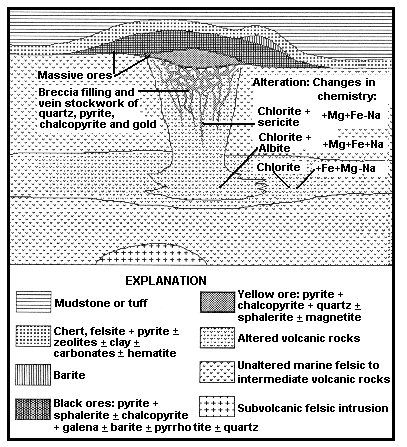
DESCRIPTIVE MODEL OF KUROKO MASSIVE SULFIDE
MODEL 28a
By Donald A. Singer
APPROXIMATE SYNONYM Noranda type, volcanogenic massive sulfide, felsic to intermediate volcanic type.
DESCRIPTION Copper- and zinc-bearing massive sulfide deposits in marine volcanic rocks of intermediate to felsic composition (see fig. 145).
Figure 145. Cartoon cross section of kuroko massive sulfide deposit. Modified from Franklin and others (1981).

GENERAL REFERENCES Ishihara (1974), Franklin and others (1981), Hutchinson and others (1982), Ohmoto and Skinner (1983).
GEOLOGICAL ENVIRONMENT
Rock Types Marine rhyolite, dacite, and subordinate basalt and associated sediments, principally organic-rich mudstone or shale. Pyritic, siliceous shale. Some basalt.
Textures Flows, tuffs, pyroclastics, breccias, bedded sediment, and in some cases felsic domes.
Age Range Archean through Cenozoic.
Depositional Environment Hot springs related to marine volcanism, probably with anoxic marine conditions. Lead-rich deposits associated with abundant fine-grained volcanogenic sediments.
Tectonic Setting(s) Island arc. Local extensional tectonic activity, faults, or fractures. Archean greenstone belt.
Associated Deposit Types Epithermal quartz-adularia veins in Japan are regionally associated but younger than kuroko deposits. Volcanogenic Mn, Algoma Fe.
DEPOSIT DESCRIPTION
Mineralogy Upper stratiform massive zone (black ore)--pyrite + sphalerite + chalcopyrite ± pyrrhotite ± galena ± barite ± tetrahedrite - tennantite ± bornite; lower stratiform massive zone (yellow ore)--pyrite + chalcopyrite ± sphalerite ± pyrrhotite ± magnetite; stringer (stockwork) zone--pyrite + chalcopyrite (gold and silver). Gahnite in metamorphosed deposits. Gypsum/anhydrite present in some deposits.
Texture/Structure Massive (>60 percent sulfides); in some cases, an underlying zone of ore stockwork, stringers or disseminated sulfides or sulfide-matrix breccia. Also slumped and redeposited ore with graded bedding.
Alteration Adjacent to and blanketing massive sulfide in some deposits--zeolites, montmorillonite (and chlorite?); stringer (stockwork) zone--silica, chlorite, and sericite; below stringer--chlorite and albite. Cordierite and anthophyllite in footwall of metamorphosed deposits, graphitic schist in hanging wall.
Ore Controls Toward the more felsic top of volcanic or volcanic-sedimentary sequence. Near center of felsic volcanism. May be locally brecciated or have felsic dome nearby. Pyritic siliceous rock (exhalite) may mark horizon at which deposits occur. Proximity to deposits may be indicated by sulfide clasts in volcanic breccias. Some deposits may be gravity-transported and deposited in paleo depressions in the seafloor. In Japan, best deposits have mudstone in hanging wall.
Weathering Yellow, red, and brown gossans. Gahnite in stream sediments near some deposits.
Geochemical Signature Gossan may be high in Pb and typically Au is present. Adjacent to deposit-enriched in Mg and Zn, depleted in Na. Within deposits--Cu, Zn, Pb, Ba, As, Ag, Au, Se, Sn, Bi, Fe.
EXAMPLES
Kidd Creek, CNON (Walker and others, 1975)
Mt. Lyell, AUTS (Corbett, 1981)
Brittania, CNBC (Payne and others, 1980)
Buchans, CNNF (Swanson and others, 1981)